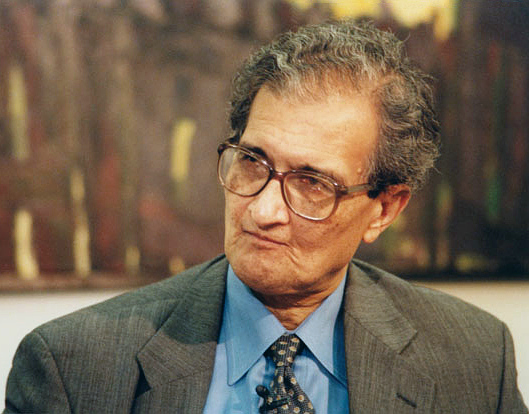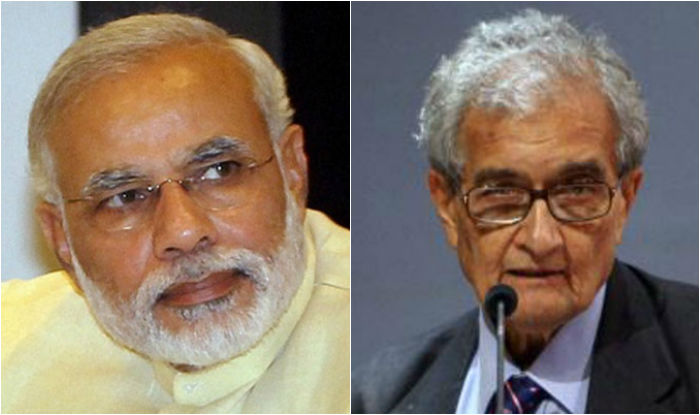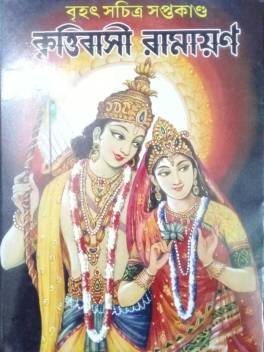
- Amartya Sen, since 2014 has turned into a ‘sen’sational political commentator. Stationed in America, he has expressed his strong dislike of having Modi as Indian Prime Minister.
- Amartya Sen maintains golden silence on why his paternal house at Dhaka became permanently inaccessible to him. He couldn’t present any scholarly logic to explain Islamic Terror but described it as Land Reform.
- Amartya Sen claimed the cultural ethos of Bengal didn’t ever include Lord Ram & “Jai Shree Ram” was no phrase for Bengalis. The reality is diametrically opposite.
- Sen’s claim that Ram is not a part of Bengal is a sad statement of falsification & appears crudely rooted in political mal-intention.
- In regular religious gatherings in different localities of Bengal, RAMAYAN GAAN was a pious routine performance. In household religious rituals like NAM SANKIRTAN & HARIR LOOT, Ram & Ramayana were & still are worshipped in Bengal.
- Rabindranath Tagore in his poem ‘PURASHKAR’ has described the spirit of both RAMAYANA & MAHABHARATA in such brevity & so lucidly that they leave a permanent mark in readers’ mind.
Before eventually turning into a political opinion-maker, Amartya Sen used to be an erudite scholar. He was extraordinary, a famous student of famous Professor Bhabatosh Dutta of Presidency College, Calcutta. However, had only merit been the prime prerequisite for Nobel Memorial Prize in Economics, there was hardly any reason why Sen’s classmate Economist Sukhamoy Chakraborty didn’t receive the same. Another stalwart Professor of Economics, Basudeb Adhikari of Calcutta University too, they say, deserved no less than Sen.
However, Amartya Sen’s image grew larger than most of his contemporary Economists some of whom were debatably more able than Sen. They say, once Sen exclaimed himself— “How’s it possible I would win a Nobel Prize before Sukhamoy?” Amartya Sen, grandson of a close associate of Rabindranath Tagore & the Second Vice Chancellor of Visva Bharati University, Kshiti Mohan Sen, had a strong reference. Apart from merit, his reference too had worked in favour. Since long before he finally bagged the Nobel Memorial Prize in 1998, Sen was expected to earn the Prize any year. Does anyone remember Leftists’ biting criticism of the Government of India for not conferring ‘Bharat Ratna’ to Amartya Sen before he received the Nobel Prize? The hype on Sen’s possibility of winning the same continued for long before he received it in fact. Such was the strength of his PR-lobby. While it is beyond question that Sen is a stalwart in theoretical Economics, it’s not sure what earned him the Nobel Prize; his merit, or PR-strength?
Silence on Bengali Hindu genocide
Amartya Sen was born in Undivided Bengal in 1933 in Dhaka to Professor Ashutosh Sen & Mrs. Amita Sen. Professor Ashutosh Sen taught Chemistry in Dhaka University. Amartya Sen’s school life thus began in St Gregory’s School, Dhaka. In 1941, Amartya was shifted to Shantiniketan & got admitted to Patha Bhavana. His family permanently shifted from Dhaka to Shantiniketan in 1945. It was the very next year when Undivided Bengal saw the first Genocide of Hindu Bengalis at Kolkata in August. The incident is infamous as Great Calcutta Killing which was shortly followed by Noakhali Genocide in October, the same year.
While Amartya Sen fondly remembers that he grew up in both Dhaka & Shantiniketan, why does he maintain golden silence why his paternal house at Dhaka became permanently inaccessible to him? While Shantiniketan still homes Amartya Sen whenever he travels in from America, why doesn’t Dhaka take him home likewise? Sen remains tongue-tied. As a scholar, Sen tried to be academically candid to explain the rationale of forceful capture of Hindus’ properties accompanied by Hindu Genocide by Islamists in Bangladesh. He described the catabolic act as ‘Land Reform’. Muslims were poor & properties of East Pakistan vested predominantly upon Hindus, Islamists were left with no option but to capture them by force—justified Sen.
Amartya Sen couldn’t present any scholarly logic to explain Islamic Terror but described it as Land Reform. However, by Leftists’ definition, Land Reform necessitates application of force. From this axiom of perception, slaughtering & driving out of Kashmiri Pandits were also Land Reform. That is perhaps why Sen didn’t speak after the Government of India framed new rules enabling Indian Citizens from all over India to purchase land in Jammu and Kashmir facilitating TRUE Land Reform. Purchase, & not forceful-capture, does NOT conform to Leftist ideology of Land Reforms. Sen bitterly criticized abrogation of Article 370. But why?

West Bengal too witnessed ‘Land Reform’ by the Left Front Government led by Jyoti Basu in 1977. Utilizing provisions of West Bengal Land Reform Act, Left Front snatched big land properties of Hindu land owners of the State. “Operation Barga” was the official nomenclature. Dividing big plots into small portions, Left Front distributed PATTA of each portion to individual bargadars predominantly belonging to Muslim Community. Rich land owners of West Bengal lost their properties for no fault of them. Sen lauded such ‘Land Reform’ & called it empowerment of the poor though there are contrarian academic views claiming Sen overstated the success of interventionist left wing administration in West Bengal.
Amartya Sen, since 2014 turned into a ‘sen’sational political commentator. Stationed in America, he has expressed his strong dislike having Modi as Indian Prime Minister. Since then, Amartya Sen launched scathing attacks towards steps taken by NDA-led ruling dispensation of India. While he utilized his scholarly image to drag additional significance to his words, Sen’s political commentary had hardly any relationship to his academic brilliance. He often spoke blatantly wrong political motivation whereof were embarrassingly evident, declining his own crafted image as an erudite scholar. While a common politician & Sen spoke the same political narrative, Sen’s version became more adverse as he’s regarded as a scholar.
Shri Ram and Ramayan part of Bengali ethos
In the recent past, Amartya Sen claimed the cultural ethos of Bengal didn’t ever include Lord Ram & “Jai Shree Ram” was no phrase for Bengalis. The reality is diametrically opposite. Before the Religious Partition of Undivided Bengal, East Bengal (where Amartya’s family originally hails from) celebrated Swadeshi Mela every year on Ramnavami. In spite of tireless efforts by Lefts & Ultra-lefts to wipe off spiritual & social impact of Lord Ram, HE was & still is a part of Bengali life & psyche. Valmiki Ramayana was translated & written in Bengali by Mahakavi Krittibas Ojha much before Poet Tulsidas wrote RAMCHARITMANAS. KRITTIBASI RAMAYAN used to be a handbook in every Bengali household & still is. People here are used to reading or listening to KRITTIBASI RAMAYAN as a way of life. Bengal is not limited to Kolkata.

In regular religious gatherings in different localities of Bengal, RAMAYAN GAAN was a pious routine performance. In household religious rituals like NAM SANKIRTAN & HARIR LOOT, Ram & Ramayana were & still are worshipped in Bengal. During HARIR LOOT, rural women of Bengal sing, “SHIVA, DURGA, RAM, KINGBA RADHESHYAM, JE BHABE JE BHABE, SE BHABE SE PAY” (one may feel the deity in whichever form he worships—Lord Shiva, Goddess Durga, Lord Ram or Lord Radheshyam). Khudiram Chattopadhyay, father of RAMKRISHNA PARAMHANSA, worshipped RAGHUVEER SHRI RAMCHANDRA as his ‘Grihdevata’. Nineteenth Century Matriarch, the founder of Dakshineswar Kali Temple, Rani Rashmani Dasi worshipped RAGHUVEER SHRI RAMCHANDRA. PARAMHANSA himself is believed to be the reincarnation of both Lord Ram & Lord Krishna in the same persona. With regard to these, Sen’s exclusion of Lord Ram from Bengali ethos may at most be considered as delirium. Tagore named Kshiti Mohan Sen’s grandson ‘Amartya’ (heavenly). Could Sen do justice to his name? Or the scholar turned too worldly?
RAMAYANA & MAHABHARATA are available in pictorial representation for kids in Bengali. Upendra Kishore Roy Chowdhury, grandfather of Satyajit Ray, has beautifully written two versions of both RAMAYANA & MAHABHARATA in Bengali— one for kids & the other for elder children. Rajshekhar Basu alias Parashuram translated Valmiki Ramayana in Bengali in 1946. Rabindranath Tagore in his poem ‘PURASHKAR’ has described the spirit of both RAMAYANA & MAHABHARATA in such brevity & so lucidly that they leave a permanent mark in readers’ mind. Those who have heartily read “PURASHKAR” even once, would perhaps not forget Tagore’s depiction of the Great Epics. Ram & Ramayana are integral parts of Bengali lives.
Innumerable other facts corroborate with the claim that Bengali life & psyche integrally included Bhagwan Shree Ram. “Hare Rama Hare Rama, Rama Rama Hare Hare, Hare Krishna Hare Krishna Krishna Krishna Hare Hare” chants every common man of Bengal till today. Many of them received RAM MANTRA as their DIKSHA MANTRA too. Children of Bengal, when afraid of ghosts, rhyme “BHOOT AMAR PUT, PETNI AMAR JHI, RAM LAKKHAN BUKE ACHE, KORBE AMAR KI” which means ‘ghosts are like my own children, how can they harm me while both Ram & Lakhsman live in my heart?’ Such is the extent of faith Bengal’s children have in Lord Ram.
Sen’s claim that Ram is not a part of Bengal is a sad statement of falsification & appears crudely rooted in political mal-intention. However, since it’s ancient wisdom to worship erudite scholars, Amartya Sen’s such claims may be ignored as ‘sen’ile decay of his cerebral capacity.
(Disclaimer: The views expressed are those of the author and do not necessarily reflect the official views or position of SamvadaWorld)
Communication Strategist, Business Consultant & Columnist
